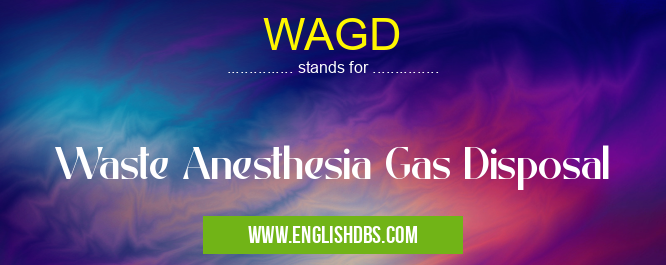What does WAGD mean in HOSPITALS
Waste Anesthesia Gas Disposal (WAGD) is a term used in the medical field to describe the methods used to safely dispose of waste gases and vapors created by the use of anesthesia. Anesthesia is a drug or technique used to control pain, numbness, and provide unconsciousness during various medical procedures. WAGD systems are designed with safety in mind and are necessary for both patient safety and environmental safety due to the hazardous chemicals present in these gases.

WAGD meaning in Hospitals in Medical
WAGD mostly used in an acronym Hospitals in Category Medical that means Waste Anesthesia Gas Disposal
Shorthand: WAGD,
Full Form: Waste Anesthesia Gas Disposal
For more information of "Waste Anesthesia Gas Disposal", see the section below.
Types of WAGD Systems
When it comes to Waste Anesthesia Gas Disposal systems there are two types: recirculating systems and exhaust systems. Recirculating systems draw in contaminated air and pass it through filters that remove particles before returning more breathable air back into the room. Exhaust systems provide ventilation directly outside of the operating room through an exhaust duct that releases potentially hazardous gases directly outside of the building where they can be passively dispersed into the environment without further contamination risks.
Essential Questions and Answers on Waste Anesthesia Gas Disposal in "MEDICAL»HOSP"
What is Waste Anesthesia Gas Disposal (WAGD)?
Waste Anesthesia Gas Disposal (WAGD) is the process of safely discarding anesthetic gases and vapors used in medical procedures. It includes not only the proper removal of anesthetic gases from the operating room, but also their safe laundering, collection and disposal.
Why is WAGD important?
Waste Anesthesia Gas Disposal is important because anesthetic gases can have serious health effects if inhaled, such as dizziness, nausea, vomiting, and even coma or death in extreme cases. Additionally, improperly discarded anesthetic gases can harm the environment.
What type of equipment is used in WAGD?
An important part of Waste Anesthesia Gas Disposal is the use of special equipment to scrub anesthetic gas from medical rooms. This includes waste gas scavenging systems which capture exhaled air containing volatile anesthetic agents and filter it before releasing it into the atmosphere; and absorbent filters that remove gas particles before being fed back into ventilation systems.
Who should be involved with WAGD?
All members of a medical setting who could be exposed to anesthetics need to be involved with Waste Anesthesia Gas Disposal. This includes doctors, nurses, technicians and any other personnel working in medical settings where anesthesia may be used.
How often should WAGD systems be inspected?
Scavenging systems for the safe removal of anesthesia gases should be inspected on a regular basis by trained personnel to ensure they are functioning correctly. Filters on these systems should also be replaced regularly according to manufacturer specifications to ensure optimal performance.
Is there a risk of exposure during WAGD processes?
Despite precautions taken in properly executing a waste anesthesia gas disposal system, some risk exists regarding exposure for both patients and personnel due to leaky or broken components. Proper training of personnel in proper operation and maintenance procedures is essential to minimize this risk.
Are there certain safety protocols that need to be followed when performing WAGD?
Yes, several safety protocols should always be followed when performing Waste Anesthesia Gas Disposal including using appropriate ventilation systems; wearing protective clothing; providing adequate training for personnel; inspecting all components of scavenging systems on a regular basis; and regularly replacing filters according to manufacturer specifications.
What kind of protective clothing should I wear while performing WAGD?
Appropriate safety gear such as respirators or safety masks with activated charcoal cartridges should always be worn when performing Waste Anesthesia Gas Disposal procedures. Additionally gloves and goggles help protect against exposure of liquids or particulates created during collection or disposal processes.
Are there any guidelines concerning proper disposal methods for collected anesthetic wastes?
Yes, all collected wastes must meet local environmental regulations when disposing including requirements regarding incineration or neutralization before release into public sewage systems or landfills respectively. Depending upon local environmental requirements additional treatment steps may also need to occur prior to final disposal.
Are there any resources available for further information on WAGD?
Yes, many organizations provide resources on best practices related to safely executing a Waste Anesthesia Gas Disposition program including OSHA’s Safety & Health Topics website which offers comprehensive information on all aspects related to WAGD operations
Final Words:
Waste Anesthesia Gas Disposal (WAGD) is an important part of any medical procedure involving anesthesia as it ensures that potentially hazardous materials created by these drugs or practices are disposed of correctly without endangering those within their vicinity or beyond them. There are two main types of WAGD systems - recirculating and exhaust - each offering its own benefits depending on specific needs or situations. In either case, having appropriate WAGD equipment installed can increase safety for both medical providers and their patients alike while ensuring environmental protection from any potential threats created by anesthetic gases being released into the atmosphere unchecked
